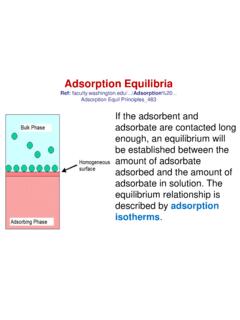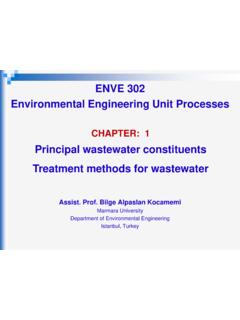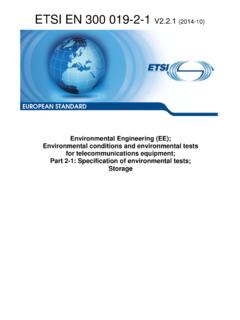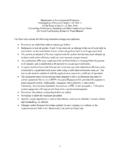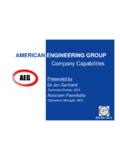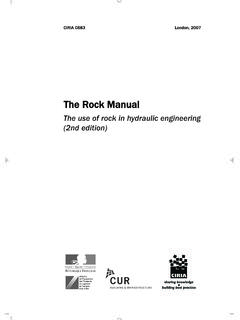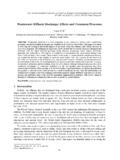Transcription of ENVE 302 Environmental Engineering Unit Processes
1 1 ENVE 302 environmental engineering unit processes Assist. Prof. Bilge Alpaslan Kocamemi Marmara University Department of Environmental Engineering Istanbul, Turkey CHAPTER: 7 Aeration Systems Air Requirement Calculations AERATION SYSTEMS Because of low solubility of oxygen , low rate of oxygen transfer; sufficient oxygen to meet the requirement of aerobic waste treatment does not enter water through normal air-water interface. To transfer the large quantites of oxygen ; additional interfaces must be formed air or oxygen can be introduced into liquid the liquid in the form of droplets can be exposed to the atmosphere 1 Factors Affecting Oxygen Transfer The rate of gas transfer is generally proportional to the difference between the existing concentration and the equilibrium concentration of the gas in solution . ()cgsdcArKC CdtV3 KLa )tLaK(0stseCCCC The overall mass transfer coefficient (KLa) is determined in test or full-scale facilities.
2 If pilot-scale facilities are used Scale up must be considered to determine KLa 4 5 Determination of KLa in clean water (ASCE, 1992) Dissolved oxygen (DO) is removed from a known volume of water by the addition of sodium sulfite Then the water is reoxygenated to mean the saturation level. During reoxygenation (reaeration) period, DO concentrations are measured Time, min DO Concentration, mg/L .. Experimental Data: Using experimental data, Cs-Ct versus t is plotted Cs-Ct time Slope = KLa / KLa = (slope) ( ) Logarithmic Scale 6 )CClog()CClog(eCCCCLa0sts)tLaK(0stsDeter mination of KLa in wastewater Uptake of oxygen by microorganisms must be considered. Typically, oxygen is maintained at a level of 1 to 3 mg/L and the microorganisms use the oxygen as rapidly as it is supplied. Rate of oxygen used by microorgnisms can be determined in lab by using respirometer 7 If the oxygen level is maintaned at a constant level, dc/dt = 0 and ; msLar)CC(Kdtdc)CC(rK)CC(KrsmLasLam8 The mass transfer coefficient KLu is a function of: Temperature Intensity of mixing (type of aeration device & geometry of mixing basin) Constituents in water Effect of Temperature on Oxygen Transfer = is a typical for both diffused and mechanical aeration devices.
3 9 )20T()C20(La)T(LaKK Effects of mixing intensity & tank geometry varies with; Type of aeration device The basin geometry The degree of mixing The ww characteristics 10 = For diffused aeration equip. = For mechanical equipment = P pel Equation )watertap(K)wastewater(KLaLa3/2)1000( of wastewater characteristics is used to correct the test system oxygen transfer rate for differences in oxygen solubility due to constituents in the water such as salts, particulates, and surface-active substances = ( is commonly used for ww) 11 )()(watertapCswastewaterCsCALCULATION OF ACTUAL AMOUNT OF OXYGEN REQUIRED UNDER FIELD CONDITIONS AOTR = actual oxygen transfer rate under field conditions, kg O2 / hr SOTR = standard oxygen transfer rate in tap water at 20 C, and zero dissolved oxygen, kg O2 / hr = salinity-surface tension correction factor = Cs (ww) /Cs(tapwater) Cs,T,H = average dissolved oxygen saturation concentration in clean water in aeration tank at temperature T and altitude H, mg/L CL = operating oxygen concentration, mg/L CS,20 = DO saturation concentration in clean water at 20 C and 1 atm, mg/L T = operating temperature, C = oxygen transfer correction factor for waste F = fouling factor (typically ) is used to account for both internal & external fouling of air diffusers.
4 12 )F)()( )(CCC(SOTRAOTR20T20,sLH,T,S13 internal caused by impurities in the compressed air Diffuser Fouling external caused by the formation of biological slimes and inorganic precipitants For surface aerators: CS,T,H = CS,T,H CS,T,H = oxygen saturation concentration in clean water at temperature T and altitude H ), mg/L (see Metcalf & Eddy, 2004, Appendix D) Pd = pressure at the depth of air release, kPa (Patm,H + Pw,effective depth) Patm,H = atmospheric pressure at altitude H, kPa (see Metcalf & Eddy, 2004, Appendix D) OT = % oxygen leaving tank (usually 18 20 % ) 14 )21 OPP(21 CCtH,atmdH,T,SH,T,SThe term in the brackets when multiplied by one-half represents the average pressure at mid depth and accounts for the loss of oxygen to biological uptake. If biological uptake is not considered, Pw,mid depth = pressure at mid depth, above point or air release due to water column.
5 15 )(,,,,,,,Hatmdepthm idwHatmHTSHTSPPPCC)21 OPP(21 CCtH,atmdH,T,SH,T,SOxygen Transfer Efficiency (OTE) of Diffusers 16 Specific Oxygen Transfer Efficiency (SOTE) of Diffusers (% OTE / m water depth ) )m/(%SpOTEdepthwatermxSpOTE(%)OTET ypical clean water transfer efficiencies (SOTE) for various diffused air devices M&E, 4th Edition Table , pg. 437 17 Example: Calculate the required total blower capacity necessary to supply oxygen requirement of kg/d for the plant having following characteristics. 18 Fine bubble aeration system DO in aeration basin = 2 g/m3 Site elevation = 500 m (pressure KLu)) = , = , F = Liquid depth for aeration basin = m The point of air release for the aerobic diffuser is m above the tank bottom Solubility of Dissolved Oxygen in Water as a Function of Salinity and Barometric Pressure Ref: Metcalf & Eddy 19 Ref: Metcalf & Eddy 20 Ref: Metcalf & Eddy 21 Table B-1 Molecular weight, specific weight, and density of gases found in wastewater at standard conditions (0 C and 1 atm) Ref: Metcalf & Eddy 22 Table B-2 Composition of dry air at 0o C and atmosphereRef: Metcalf & Eddy 23 Ref: Metcalf & Eddy 24 Ref.
6 Metcalf & Eddy 25 Aeration Systems Used for WW Treatment Diffused Air Systems Blower , air mains, header pipes through which air passes Diffusers that are submerged in ww Mechanical Aeration Systems Aerations w/ vertical axis surface aerator submerged aerator Aeration w/ horizontal axis surface aerator submerged aerator High Purity Oxygen Systems Downflow bubble contactor U tube contacter 26 Porous diffusers Non-porous diffusers Other diffusion devices Domestic disks membranes Tubes Plutes Typical Porous Air Diffusers 27 Typical Porous Air Diffusers (continue) 28 Diffused Air Aeration Systems the size of bubbles varies from coarse to fine fine-bubble diffusers coarse bubble diffusers 29 air is introduced into liquid being aerated in the form of bubbles which typically rise through the liquid common device for ; transferring oxygen in aerobic biological treatment systems stripping of volatile organics COARSE BUBBLE FINE BUBBLE Ref: Ref: Diffused Air Aeration Systems (continue) Porous diffusers ( , plate, dome, disc, tubular diffusers) Nonporous diffusers ( , fixed orifice, valved orifice) Other diffusers ( , jet aeration) 30 gas transfer rate size of bubbles smaller bubbles greater A/ more efficient than larger sized bubbles for mass transfer 31 Dome, disc diffusers are mounted on or screwed into air manifolds Ref: Metcalf & Eddy, 1991, McGraw Hill DOME DIFFUSER DOME DIFFUSER DISC DIFFUSER Typical Porous Diffusers Diffused Air Aeration Systems (continue) 32 Produce larger bubbles than porous diffusers Lower aeration efficiency Lower cost, less maintanance Typical Non Porous Diffusers Ref.
7 Metcalf & Eddy, 1991, McGraw Hill Valved orifice diffuser VALVED ORIFICE DIFFUSER (non porpous diffuser) Device that contains a check value to prevent backflow when air is shut off. Mounts on air distribution piping. Perforated tube diffuser Diffused Air Aeration Systems (continue) Ref: Metcalf & Eddy, 1991, McGraw Hill 33 Jet aerator discharges a mixture of pumped liquid and compressed air through a nozzle. Jet aerator Aspirating aerators Typical Other Diffusion Devices Diffused Air Aeration Systems (continue) 34 35 36 37 38 DIFFUSER PERFORMANCE The efficiency of oxygen transfer depends on many factors; Type, size, and shape of diffuser The air flowrate The depth of submersion Tank geometry including the header and diffuser location ww characteristics Aeration devices evaluated in clean water (SOTE, standard oxyen transfer efficiency) the results are adjusted to process operating conditions 39 Typical Nonporous Air Diffusers (continue) Non-porous Diffusers; (produce more bubble than porous diffusers) Orifice tube 40 Other Diffusion Devices Other Diffusion Devices Jet aerator Aspirating aerator U-tube 41 Other Diffusion Devices (continue) 42 Blowers; 3 types of blower are commonly used for aeration.
8 Centrifugal Rotary lobe positive displacement Inlet guide vane-variable diffuser 43 Centrifugal blowers (capacity > 425 m3/min discharge pressure ranges 48-62 kN/m2 similar to low-specific-speed centrifugal pumps the operating point is determined by the intersection of the head-capacity curve and system curve 44 Rotary lobe positive displacement (capacity < 425 m3/min) for higher discharge pressure applications > 55 kN/m2 is a machine of constant capacity w/ variable pressure the units can not be throttled but capacity control can be obtained by the use of multiple units or a variable speed drive 45 a relatively new blower design a single stage centrifugal operation that incorporates activaters to position the inlet guide vane and variable diffuser to vary blower flowrate. well suited to applications with medium to high fluctuations in inlet temperature, discharge pressure and flowrate 46 Inlet guide vane-variable diffuser (capacity 85 1700 m3/min) blower capacity 85 1700 m3/min at pressures up to 170 kN/m2 turndown rate (Qmin/Qmax) : 40% is possible w/o significant reduction in operating efficiencies high initial cost , sophisticated computer control system In WWTP, blowers must supply a wide range of airflows under varied Environmental conditions.)
9 Provisions have to be included in the blower system design to regulate or turndown the blowers 47 Methods to achieve regulation or turndown; Flow blow-off or by passing effective method of controlling surging of a centrifugal blower Inlet throttling are applicable only to adjustable discharge diffuser centrifugal blowers variable speed driver more commonly used on positive displacement blowers parallel operation or multiple units MECHANICAL AERATORS By producing a large air-water interface the transfer of oxygen from atmosphere is enhanced Can be VERTICAL SHAFT or HORIZONTAL SHAFT 48 Ref: Ref: MECHANICAL AERATOR PERFORMANCE are rated in terms of kg O2 / kw hr at standard conditions, 20 C, DO = 0, test liquid is tap water. commercial size surface aerators range in efficiency from kg O2 / kwhr 49 For design purposes, the standard performance data must be adjusted to reflect field conditions by using the following equation; ) )CC(NNN = kg O2/ transferred under field conditions No = kg O2 transferred in water at 20 C, and 0 DO.
10 = salinity-surface tension correction factor (usually 1) Cwalt= oxygen saturation concentration for tap water at given temperature and altitude (Appendix D) (Figure ) CL = operating oxygen concentration, mg/L T = temperature, C = oxygen transfer correction factor for waste (Table , ) Figure (Metcalf & Eddy, 2004 Elevation, 103 Oxygen Solubility Correction Factor (Fa) 50 xFa)levelseaat(Cs)alt(Cs51 Oxygen transfer data for various types or mechanical aerators Table , pg. 446 (Metcalf & Eddy, 4th Edition))


